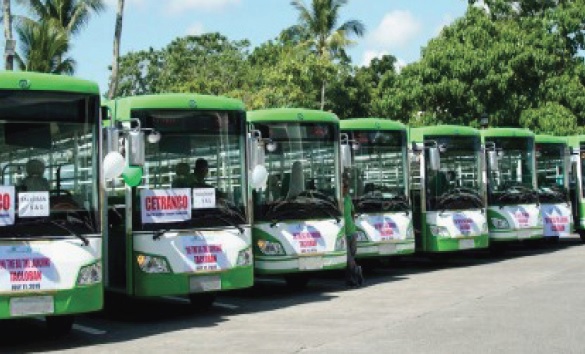
(Photo courtesy of Tacloban City government)
TACLOBAN CITY- Commuting experience has never been dignified for Gerry Montellano until after the national government piloted the public utility vehicles (PUV) modernization program in this city.
For over a year now, Montellano, 25, has been taking a 40-minute trip daily from a relocation site in Suhi village to the city’s downtown, where he works as a goldsmith to support his family.
“I always prefer to ride the solar jeepney because of its bigger space and comfortable seats. For a man with long legs like me, it is very uncomfortable to ride a multi-cab or a very crowded old jeepney,” he told the Philippine News Agency (PNA).
The Department of Transportation launched the PUV modernization program in this city on Jan. 23, 2018 to “overhaul” the country’s public transportation system.
This is one of the priority projects of President Rodrigo Duterte to provide a more dignified commuting experience.
The program has initially deployed 45 solar-powered jeepneys supplied by the Star8 Green Technology Corp. The number of units has doubled this year.
The jeepneys initially covered the Tacloban-Palanog route, which is intended to improve accessibility to resettlement sites occupied by thousands of super typhoon Yolanda survivors.
This year, the project has launched new routes in the city.
“I wish the government will push through this modernization program for the safety and comfort of thousands of commuters. This is way better than aging jeepneys and tiny multicabs,” Montellano said.
Solar jeepney driver Rodolfo Solidor, 60, said driving the modern jeepney has encouraged him to extend his working years. The old man, who earns P320 to P500 daily, has been driving the solar jeepney since its launching here early 2018.
Each unit carries 22 passengers with free Wi-Fi on board, overhead electric fan per passenger, and USB power port to charge their devices.
It has a capacity to travel approximately 100 kilometers on a full battery charge, and adding another 10-15 km from the solar production during daylight hours.
“Its power steering makes it easier for me to drive this jeepney especially for an old man like me. I can drive for as long as I can breathe,” said Solidor who has been transporting commuters to the new Eastern Visayas Regional Medical Center and relocation sites in Kawayan village.
He shared that after working as a driver for over three decades, he never had social and health insurance until Star8 Green Technology Corp. hired him last year.
The solar jeepneys, designed to replace the aging combustion engine fleet, have initially operated in the city starting mid-December 2017.
On July 11, the company launched 20 more solar jeepneys to ply new routes from the city’s downtown.
“This is really introducing better technology for the public and better jobs for the people. This will address the transportation needs of the city’s one million day-time population. It’s really important to provide mobility and convenience for the people,” said Mayor Alfred Romualdez during the launch.
The PUV modernization is a flagship project of the Duterte administration, which aims to restructure, modernize and make an environment-friendly transport system in the country.
The program also aims to provide drivers and operators with stable, sufficient and dignified livelihoods and at the same time, to let the commuters enjoy a safe and comfortable transportation system.
“You know the machines, the engines of public utility jeepneys, are about 20 to 25 years old. We got them from other countries. The reconditioned ones were sold here and they have been pumping in so much carbon dioxide into the air, including the factories,” President Duterte said during a federalism forum sometime in October 2017.
State-run Land Bank of the Philippines and Development Bank of the Philippines earlier announced the availability of multi-billion loans to finance the acquisition of new PUVs to qualified prospective borrowers.
(SARWELL Q. MENIANO/PNA)



